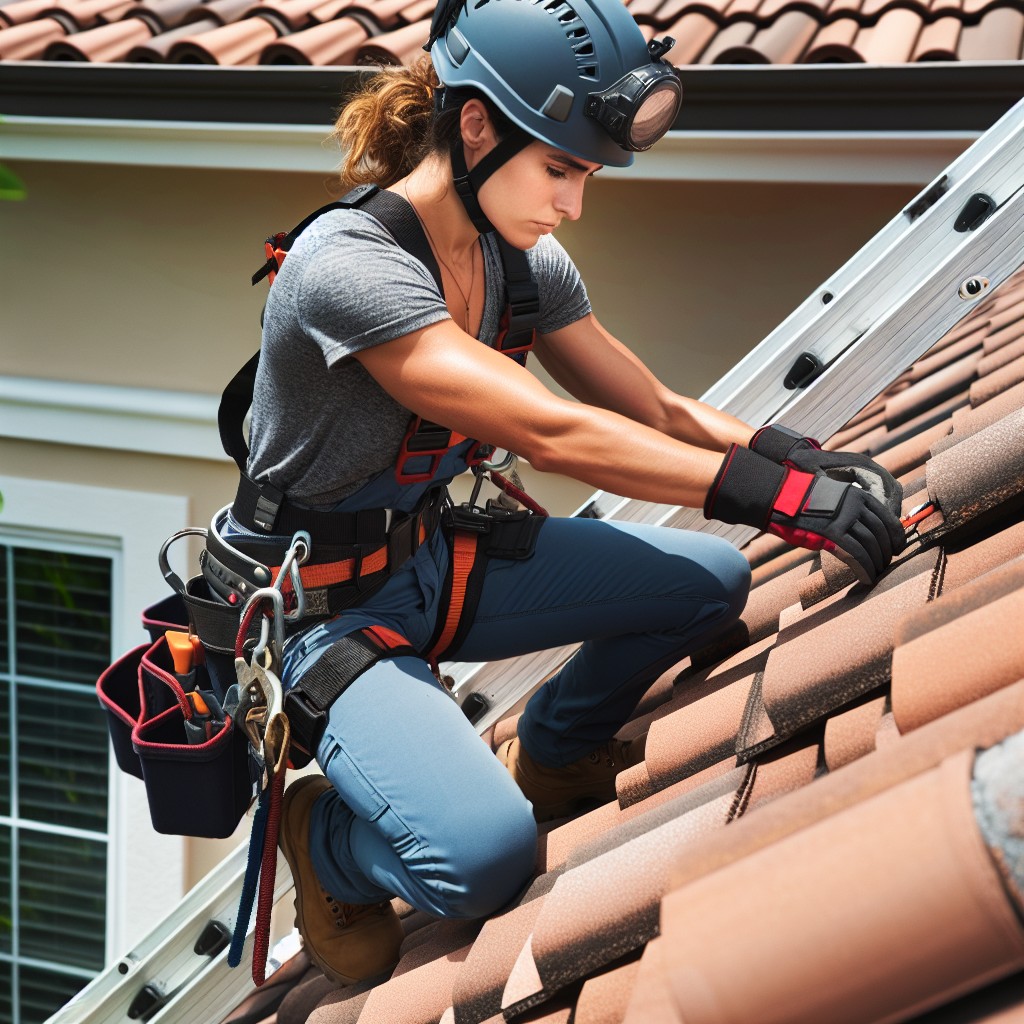Last updated on
Walking on a clay tile roof requires special precautions; this article will provide detailed instructions on how to do it safely and without causing damage.
Key takeaways:
- Use a stable ladder and ladder stabilizer for safety.
- Choose soft, non-slip rubber sole shoes with good ankle support.
- Step on lower portion of tiles and avoid edges or corners.
- Distribute weight evenly and move slowly and deliberately.
- Consider weather conditions, tile condition, and local regulations.
Getting On Your Roof Safely

Before attempting to access your clay tile roof, ensure that you have a stable, extendable ladder which reaches at least three feet above the roof line for a secure grip. Place the ladder on firm, level ground to prevent slipping or tipping. Secure the ladder at the top, if possible, to the edge of the roof with a ladder stabilizer or roof hooks for added stability.
Always have a spotter—a person who will hold onto the ladder and keep an eye on you as you ascend and descend. Take each step deliberately, maintaining three points of contact at all times—two hands and one foot or two feet and one hand on the ladder. Avoid windy or wet conditions, which can drastically increase the risk of slips or falls. If you’re not experienced with working at heights, consider using a roof harness system for added safety.
Proper Footwear Selection
Selecting the right footwear is crucial for both safety and roof integrity. Shoes with soft, non-slip rubber soles afford the best grip, reducing the risk of slipping. Avoid shoes with hard soles or heavy tread patterns that can break or dislodge tiles. Flat soles are preferable, as they help distribute your weight more evenly.
Ensure that the shoes are snug-fitting to prevent tripping over loose fabric or laces. It’s also wise to choose footwear that provides good ankle support to help with balance on the sloped surface of the roof. Keep in mind the condition of the roof; if it’s wet or has moss, extra care is needed as these conditions further reduce traction.
Stepping On the Tiles
When navigating a clay tile roof, concentrate on placing your feet in areas that can best support your weight. Aim for the lower portion of the tiles, or where one tile overlaps another; this is typically where the tiles are most supported from underneath. Always step gently, pressing down with the balls of your feet rather than your heels to minimize pressure on individual tiles. Avoid stepping on the edges or corners, as these points are more prone to cracking or breaking under stress.
Move slowly and deliberately, being mindful of your balance to prevent any sudden shifts in weight or missteps that could damage the tiles or pose a personal safety risk. Remember, each step should be thoughtful to ensure the integrity of the roof and your own safety.
Weight Distribution While Moving
To minimize the risk of damage to clay tiles, it’s essential to distribute your weight evenly across multiple points of contact. Focus on balance and steady movement, ensuring that your center of gravity aligns with the points of support. Use a “tripod” approach when possible:
- Stand with feet shoulder-width apart to balance body weight proportionately.
- Move softly, stepping gently and deliberately to avoid placing too much pressure on any single tile.
- Glide rather than step; consider a technique akin to walking on ice, keeping movements smooth and controlled.
- Engage your core muscles for added stability as you traverse the surface.
- Plan your path to step on the lower third of visible tiles, where strength is greatest due to underlying support.
Remember, swift movements can lead to slipping or tile breakage, so take your time and focus on gentle, even steps for safety and preservation of your roof.
Warnings
Clay tiles are extremely fragile and can crack or break under pressure, so it’s crucial to consider the following before attempting to traverse your roof:
- Weather conditions: Avoid walking on clay tiles when they are wet or during extreme temperatures, as this can make them more slippery and prone to damage.
- Tile condition: Inspect the tiles from a safely positioned ladder first. Cracked or loose tiles are hazardous and should be repaired before any attempt to walk on them.
- Local building codes: Check for any regulations that may impact the approach and safety precautions required for roof work.
- Professional assessment: If you’re uncertain about the roof’s integrity or your ability to safely navigate it, consulting with a professional roofer is advisable.
Remember, personal safety and the preservation of your roof should always take precedence.
FAQ
What is under a clay tile roof?
Underneath a clay tile roof, one might find an underlayment, in many cases either a 30-pound felt paper or a non-bitumen synthetic material.
Do clay roof tiles break easily?
Clay roof tiles, although highly resistant to elements like high winds, fire, and hail, are quite brittle and can break easily, especially during the installation process.
How much weight can roof tiles support?
Most residential roofs are designed to support between ten to twenty pounds per square foot of structural elements and associated materials.
How can you determine the quality of a clay tile roof?
The quality of a clay tile roof can be determined by evaluating its durability, resilience, proper installation, weight, overall appearance, and the reputation of the manufacturer.
What are some effective methods for cleaning clay roof tiles?
Effective methods for cleaning clay roof tiles include using a low-pressure power washer, applying a moss and fungus killer, and subsequently brushing off the dirt and debris.
What’s the best way to replace a damaged clay roof tile?
The best way to replace a damaged clay roof tile is by carefully removing the broken tile, preparing the area by cleaning it of debris, and then installing the new tile with roofing cement to secure it in place.




